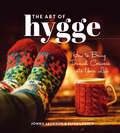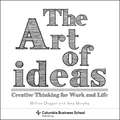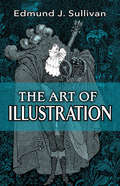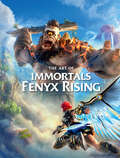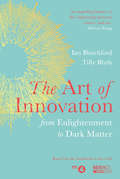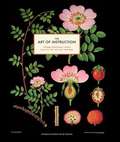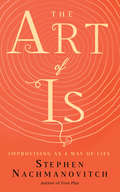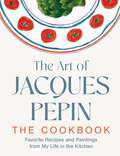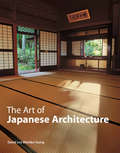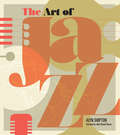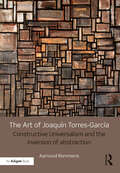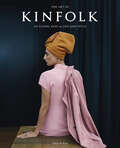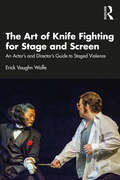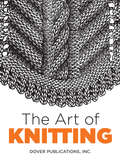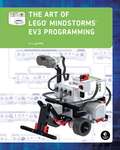- Table View
- List View
The Art of Hygge: How to Bring Danish Cosiness Into Your Life
by Jonny Jackson Elias LarsenThe Art of Hygge is packed with delicious recipes to share with friends, craft ideas for decorating your home, and inspirational suggestions for enjoying the magic of everyday pleasures. Whether it’s a soothing mug of hot chocolate, a tasty butternut squash soup or a snuggly pair of felt slippers, you’ll find that a little hygge brings a lot of happiness!
The Art of Ideas: Creative Thinking for Work and Life (Columbia Business School Publishing Ser.)
by William Duggan Amy Murphy Laura DabalsaGreat ideas don’t just happen. Innovation springs from creative thinking—a method of the human mind that we can study and learn. In The Art of Ideas, William Duggan and Amy Murphy bring together business concepts with stories of creativity in art, politics, and history to provide a visual and accessible guide to the art and science of new and useful ideas.In chapters accompanied by charming and inviting illustrations, Duggan and Murphy detail how to spark your own ideas and what to do while waiting for inspiration to strike. They show that regardless of the field, innovations happen in the same way: examples from history, presence of mind, creative combination, and resolution to action. <P><P> The Art of Ideas features case studies and exercises that explain how to break down problems, search for precedents, and creatively combine past models to form new ideas. It showcases how Picasso developed his painting style, how Gandhi became the man we know today, and how Netflix came to disrupt the movie-rental business. Lavishly illustrated in an appealing artistic style, The Art of Ideas helps readers unlock the secret to creativity in business and in life.
The Art of Illustrated Maps: A Complete Guide to Creative Mapmaking's History, Process and Inspiration
by John RomanWhile literally hundreds of books exist on the subject of "cartographic" maps, The Art of Illustrated Maps is the first book EVER to fully explore the world of conceptual, "imaginative" mapping. Author John Roman refers to illustrated maps as "the creative nonfiction of cartography," and his book reveals how and why the human mind instinctively recognizes and accepts the artistic license evoked by this unique art form. Drawing from numerous references, The Art of Illustrated Maps traces the 2000-year history of a specialized branch of illustration that historians claim to be "the oldest variety of primitive art." This book features the dynamic works of many professional map artists from around the world and documents the creative process as well as the inspirations behind contemporary, 21st-century illustrated maps.
The Art of Illustration
by Edmund J. SullivanAn influential teacher whose pen-and-ink drawings helped define the style of the early twentieth century, Edmund J. Sullivan sought to define the principles behind good illustration. His treatise - richly illustrated with black-and-white engravings by Holbein, Dürer, Rubens, Blake, and many others - also offers suggestions on materials and methods. Sullivan, who came of age during the heyday of graphic design and book illustration, was a firm believer in free but faithful artistic interpretations. In The Art of Illustration, he conducts a fascinating journey through art history that ranges back and forth in time from his contemporaries -- including Beardsley, Doré, and Whistler -- to Botticelli and other old masters. Sullivan's knowledgeable and informative discourse covers symbolism, cartoons, the use of models, the illustration of poetry and plays, children's books, and a host of other topics of enduring interest to artists and art lovers.
The Art of Image Processing with Java
by Kenny A. HuntThis introductory image processing text is ideal for college students studying computer science or software engineering. With an emphasis on software design, the text builds on an accessible mathematical foundation and on extensive sample Java code to teach students the fundamentals of image processing. The text is accompanied by rich illustrations that demonstrate the results of performing processing on famous art pieces. This approach gives readers real-world examples of ways they may use image processing. Each chapter includes problems for students, and an online supplement offers instructor resources.
The Art of Immortals: Fenyx Rising
by UbisoftA fanciful full-colored tome chronicling the development of the hotly anticipated video game Immortals Fenyx Rising(TM) from Ubisoft EntertainmentThe creative team of Ubisoft Quebec presents a fantastical world based on mythological tales, rife with creatures such as bestial minotaur, gigantic cyclops, evil chimera, ferocious harpies, and the terrifying Medusa. This volume offers an inside look at the craft behind that massive and magical land, wherein readers will find themselves taking part in a heroic journey that spans the lush paradisiacal lands of Aphrodite the goddess of love, through the scarred battlefield and fortress of Ares the god of war, up Mount Olympus--home of the mighty Zeus, down into the darkest corners of the underworld. and much more! Not only does this book lend insights into designs of Fenyx, a new winged Greek hero, with their legendary weapons and armor, but also the environments that players will explore, the creatures they will encounter and--most importantly--the gods themselves, who seek aid against the fearsome titan and father of all monsters, Typhon! The Art of Immortals Fenyx Rising gives readers unique insights into the masterful development of a memorable gaming experience. This collection of concept art and creator commentary is sure to engage any fan of games, art, or ancient myth!
The Art of Innovation: From Enlightenment to Dark Matter, as featured on Radio 4
by Ian Blatchford Tilly BlythBased on the landmark Radio 4 series, this beautifully illustrated modern history of the connections between science and art offers a new perspective on what that relationship has contributed to the world around us. __________ Throughout history, artists and scientists have been driven by curiosity and the desire to experiment. Both have wanted to make sense of the world around them, often to change it, sometimes working closely together, certainly taking inspiration from each other's disciplines. The relationship between the two has traditionally been perceived as one of love and hate, fascination and revulsion, symbiotic but antagonistic. But art is crucial to helping us understand our science legacy and science is well served by applying an artistic lens. How exactly has the ingenuity of science and technology been incorporated into artistic expression? And how has creative practice, in turn, stimulated innovation and technological change?The Art of Innovation is a history of the past 250 years viewed through the disciplines of art and science. Through fascinating stories that explore the sometimes unexpected relationships between famous artworks and significant scientific and technological objects - from Constable's cloudscapes and the chemist who first measured changes in air pressure, to the introduction of photography and the representation of natural history in print - it offers a new way of seeing, studying and interpreting the extraordinary world around us.
The Art of Instruction
by Katrien Van der SchuerenLarge-scale wall charts were fundamental tools of classroom instruction throughout Europe in the mid-nineteenth and twentieth centuries. Collected here for the first time in one deluxe volume are over 100 of these vintage educational posters now important relics in the history of science, art, and design. From the anatomy of a tulip or an apple tree to that of a hedgehog or starfish, the botanical and zoological images in this collection are captivating with their curious visuals and intricate details. With a compelling introduction about the history of educational charts and their production, The Art of Instruction provides a glimpse into a rich, significant heritage and will enlighten those with an interest in art, design, science, or natural history.
The Art of Is: Improvising as a Way of Life
by Stephen NachmanovitchA MASTERFUL BOOK ABOUT BREATHING LIFE INTO ART AND ART INTO LIFE &“Stephen Nachmanovitch&’s The Art of Is is a philosophical meditation on living, living fully, living in the present. To the author, an improvisation is a co-creation that arises out of listening and mutual attentiveness, out of a universal bond of sharing that connects all humanity. It is a product of the nervous system, bigger than the brain and bigger than the body; it is a once-in-a-lifetime encounter, unprecedented and unrepeatable. Drawing from the wisdom of the ages, The Art of Is not only gives the reader an inside view of the states of mind that give rise to improvisation, it is also a celebration of the power of the human spirit, which — when exercised with love, immense patience, and discipline — is an antidote to hate.&” — Yo-Yo Ma, cellist
The Art of Jacques Pépin: Favorite Recipes and Paintings from My Life in the Kitchen
by Jacques PépinIn celebration of legendary chef Jacques Pépin’s legacy and two premier passions in life, a stunning, curated collection of his favorite recipes and signature artworks.Just in time for his 90th birthday, The Art of Jacques Pépin celebrates master chef Jacques Pépin and his life of cooking and painting, with 99 of his all-time favorite and most-cooked recipes paired with pieces of his signature artworks spanning the last 60 years. Chapters cover all courses for a satisfying meal at home, including desserts, and his artworks are thoughtfully curated accordingly. The recipes are authentic Pépin essence—timelessly classic, delicious, and surprisingly achievable, including:Bread and Onion SoupRadicchio Salad with Garlic DressingStew of Spring VegetablesBaked Salmon with Pesto ButterChicken Legs with YamsPork Roast with RatatouilleChocolate Soufflé Oranges in CaramelA true creative expression of Jacques Pépin, this beautifully illustrated cookbook will inspire you to cook and create as Jacques does.As Jacques Pépin always signs off, happy cooking.
The Art of Japanese Architecture
by David Young Michiko Young Tan Hong YewThe Art of Japanese Architecture explores the simplicity, asymmetry, sensitivity to the natural environment, and use of natural materials that are the hallmarks of Japanese architecture. These elements are explored and clarified in this cultural and historical overview of the rapidly changing world of Japanese architecture.Beginning with a discussion of prehistoric pit dwellings and concluding with a description of significant modern buildings, David and Michiko Young, authors of the 2006 American Horticultural Award-winning book, The Art of the Japanese Garden, analyze the major changes in architecture caused by the introduction of Buddhist culture, the development of feudalism, the influence of Western culture and the adaptation of the international style in contemporary buildings.
The Art of Jazz: A Visual History
by Alyn ShiptonThe Art of Jazz explores how the expressionism and spontaneity of jazz spilled onto its album art, posters, and promotional photography, and even inspired standalone works of fine art.Everyone knows jazz is on the cutting edge of music, but how much do you know about its influence in the visual arts? With album covers that took inspiration from the avant-garde, jazz's primarily African American musicians and their producers sought to challenge and inspire listeners both musically and visually.Arranged chronologically, each chapter covers a key period in jazz history, from the earliest days of the twentieth century to today's postmodern jazz. Chapters begin with substantive introductions and present the evolution of jazz imagery in all its forms, mirroring the shifting nature of the music itself. With two authoritative features per chapter and over 300 images, The Art of Jazz is a significant contribution to the literature of this intrepid art form.
The Art of Jeffrey Rubinoff
by James FoxJeffrey Rubinoff is one of the great sculptors in steel of the second half of the twentieth century. In the 1970s and '80s he exhibited widely in the United States and Canada alongside Anthony Caro, Mark di Suvero and George Rickey, among others. However, in the early 1990s Rubinoff withdrew from the art world altogether and concentrated on creating an extraordinary sculpture park on Hornby Island. This book is the first major account of his remarkable career.The Art of Jeffrey Rubinoff considers Rubinoff's life, work and ideas from a variety of perspectives. Barry Phipps describes Rubinoff's working methods; James Purdon examines the meanings that derive from Rubinoff's use of steel; Joan Pachner focuses on the formative influence of the abstract Expressionist sculptor David Smith on his work; Maria Tippett examines Rubinoff through the lens of the broader arts scene in postwar Canada; and Aaron Rosen attempts to understand Rubinoff's values and ambitions in light of his Jewish heritage. Other contributing scholars include Alistair Rider, Mark E. Breeze, Tom Stammers, Alexander Massouras, David Lawless and Peter Clarke. The book's foreword is written by the distinguished Yale historian Jay Winter.Drawing on interviews and correspondence with Rubinoff himself, as well as uncatalogued archives and unpublished documents in the artist's possession, The Art of Jeffrey Rubinoff makes available for the very first time a significant quantity of primary material, both textual and visual, for scholars and students of the future.
The Art of Joaquín Torres-García: Constructive Universalism and the Inversion of Abstraction
by Aarnoud RommensIntertwining art history, aesthetic theory, and Latin American studies, Aarnoud Rommens challenges contemporary Eurocentric revisions of the history of abstraction through this study of the Uruguayan artist Joaquín Torres-García. After studying and painting (for decades) in Europe, Torres-García returned in 1934 to his native home, Montevideo, with the dream of reawakening and revitalizing what he considered the true indigenous essence of Latin American art: "Abstract Spirit." Rommens rigorously analyses the paradoxes of the painter's aesthetic-philosophical doctrine of Constructive Universalism as it sought to adapt European geometric abstraction to the Americas. Whereas previous scholarship has dismissed Torres-García's theories as self-contradictory, Rommens seeks to recover their creative potential as well as their role in tracing the transatlantic routes of the avant-garde. Through the highly original method of reading Torres-García's artworks as a critique on the artist's own writings, Rommens reveals how Torres-García appropriates the colonial language of primitivism to construct the artificial image of "pure" pre-Columbian abstraction. Torres-García thereby inverts the history of art: this book teases out the important lessons of this gesture and the implications for our understanding of abstraction today.
The Art of John Harris: Volume II - Into the Blue
by John HarrisThis second volume from Titan Books is a collection of world-renowned visionary artist John Harris&’ unique paintings captures breath-taking, otherworldly vistas on a massive scale.The Art of John Harris II: Into the Blue is the third collection (second collection published by Titan) of world-renowned visionary artist John Harris&’ unique paintings that capture future worlds on a massive scale, from vast landscapes and towering cities to breath-taking vistas. Readers will get a unique insight into the creative process behind the worlds depicted in the paintings as Harris takes them on a journey from sketch to finished painting, as well as his striking covers for a variety of esteemed science fiction authors, including John Scalzi, Ben Bova, Jack McDevitt, Orson Scott Card, Ann Leckie and many more.
The Art of Keeping Cool
by Janet Taylor LisleThe War At Home Fear permeates the Rhode Island coastal town where Robert, his mother, and sister are living out the war with his paternal grandparents: Fear of Nazi submarines offshore. Fear of Abel Hoffman, a German artist living outside of town.
The Art of KeyForge
by AsmodeeA fantastic full-color digital book that features a staggering array of artwork--all from the massively popular card game!Explore the Crucible and the distinct houses of KeyForge through a gorgeously designed collection of the game's masterfully created art! At the center of the KeyForge universe stands an enigmatic world built from the disparate pieces of countless planets, where players must use their unique decks of cards to unlock mysterious hidden Vaults! This vibrant art book explores KeyForge's contest of power and wit with hundreds of illustrations that demonstrate the countless possibilities that are available across every deck, showcasing the whimsical and exciting art in glorious detail! This tome is a must-have for readers ranging from the most dedicated Archons to casual fans of games and science-fantasy! Join the legions of players who've made this game a smash success, and witness the Crucible for yourself!
The Art of Kinfolk: An Iconic Lens on Life and Style
by John BurnsAn inspiring collection of the best images from the tastemaking Kinfolk magazine With over 650,000 copies of their books in print and nearly 50 issues of their magazine distributed worldwide, Kinfolk has come to define the taste of a generation: From interiors to fashion, portraiture, food and travel, the consistently boundary-pushing photography produced by the brand has coalesced into one of the most influential and immersive lifestyle aesthetics of the last decade. The Art of Kinfolk brings more than 300 of the most iconic images from the first decade of the magazine into focus. Ranging from the deceptively simple to the surreal to the perennially stylish, this collection of originally commissioned photography captures the arc of an artistic adventure, a creative community at work, and in the process illuminates one of the most enigmatic aesthetics of the era.
The Art of Knife Fighting for Stage and Screen: An Actor’s and Director’s Guide to Staged Violence
by Erick Vaughn WolfeThe Art of Knife Fighting for Stage and Screen: An Actor’s and Director’s Guide to Staged Violence provides detailed information for the safe use of knives and daggers in a theatrical setting and an in-depth understanding of safe theatrical weapons. The book starts with an extensive safety review, then moves on to the basic techniques of dagger fighting, starting with grip and body postures. Readers will then learn about the basic actions of cuts, parries, blocks, and disarms. During this process, they will explore the connection between body and weapon and start learning the elements of storytelling through choreography. Special attention is given to suicides, threats, and murder and how directors, choreographers, performers, teachers, and students can approach these techniques in a way that is physically and mentally safe. The book also covers the use of throwing knives, knife flips, and other tricks to help add a little flair to your fight. The Art of Knife Fighting for Stage and Screen teaches the safe theatrical use of the knife for directors, performers, educators, and students of stage combat.
The Art of Knitting (Dover Knitting, Crochet, Tatting, Lace)
by Butterick Publishing Co. Inc. Dover PublicationsComprehensive in scope and elegant in presentation, this classic Victorian-era volume was the first complete how-to guide to knitting. Originally published by Butterick, the company that later produced Vogue Knitting, it constitutes a fantastic historical document as well as an easy-to-follow guide for knitters at all levels of experience. In addition to basic knitting instructions and a dictionary of stitches, the book offers illustrated patterns for dozens of projects, including sweaters, scarves, hats, and other items for women, men, and children. Starting with a chapter of general directions, the guide presents examples of fancy stitches, including edging designs for mittens and socks, borders for scarves and shawls, and knitted edgings and insertions. Ladies' apparel and accessories include hoods, capes, shawls, jackets, fascinators, leggings, and many other projects. Menswear includes sweaters, belts, scarves, ties, and more. In addition to children's clothing and toys, the book also features patterns for counterpanes, spreads, doilies, mats, and other household articles.
The Art of Kubo and the Two Strings
by Emily HaynesFrom LAIKA, the Academy Award®-nominated studio behind Coraline, ParaNorman, and The Boxtrolls, comes a new adventure set in a mythical ancient Japan. In Kubo and the Two Strings, scruffy, kind-hearted Kubo cares devotedly for his mother while eking out a humble living in their sleepy shoreside village. But when a spirit from the past appears, Kubo suddenly finds himself entwined in a violent struggle against gods and monsters. This fully illustrated book offers a behind-the-scenes view of the amazingly detailed artwork and unique stop-motion animation style involved in the film's creation.
The Art of LEGO Design: Creative Ways to Build Amazing Models
by Jordan SchwartzThe most impressive LEGO models often take careful planning (and lots of pieces), but with some inspiration, a little imagination, and a number of tried-and-true techniques, you too can turn bricks into a masterpiece.In The Art of LEGO® Design, author Jordan Schwartz explores LEGO as an artistic medium. This wide-ranging collection of creative techniques will help you craft your own amazing models as you learn to see the world through the eyes of some of the greatest LEGO builders. Each concept is presented with a collection of impressive models to spark your imagination—like fantastic dragons, futuristic spaceships, expressive characters, and elaborate dioramas.You’ll discover some of the inventive techniques that LEGO artists use to:–Create lifelike creatures from unusual elements like inside-out tires and minifigure capes–Design sleek cars without showing a single stud–Add ambience to dioramas with light bricks or LEDs–Craft eye-catching textures to create cobblestone roads and brick walls–Build sturdy, detailed, posable mechs and other figures–Add depth with forced perspective and interesting silhouettesInterviews with the talented builders behind many of the book’s models reveal their thoughts on the design process and what inspires them most. Even if you’ve been building with LEGO since you could crawl, you’ll find new inspiration in The Art of LEGO® Design.
The Art of LEGO MINDSTORMS EV3 Programming
by Terry GriffinWith its colorful, block-based interface, The LEGO® MINDSTORMS® EV3 programming language is designed to allow anyone to program intelligent robots, but its powerful features can be intimidating at first. The Art of LEGO MINDSTORMS EV3 Programming is a full-color, beginner-friendly guide designed to bridge that gap.Inside, you’ll discover how to combine core EV3 elements like blocks, data wires, files, and variables to create sophisticated programs. You’ll also learn good programming practices, memory management, and helpful debugging strategies—general skills that will be relevant to programming in any language.All of the book’s programs work with one general-purpose test robot that you’ll build early on. As you follow along, you’ll program your robot to:–React to different environments and respond to commands–Follow a wall to navigate a maze–Display drawings that you input with dials, sensors, and data wires on the EV3 screen–Play a Simon Says–style game that uses arrays to save your high score–Follow a line using a PID-type controller like the ones in real industrial systemsThe Art of LEGO MINDSTORMS EV3 Programming covers both the Home and Education Editions of the EV3 set, making it perfect for kids, parents, and teachers alike. Whether your robotics lab is the living room or the classroom, this is the complete guide to EV3 programming that you’ve been waiting for.Requirements: One LEGO MINDSTORMS EV3 Home OR Education set (#31313 OR #45544).
The Art of LEGO Scale Modeling
by Dennis Glaasker Dennis BosmanThe Art of LEGO Scale Modeling displays amazing, fan-built LEGO recreations of real-life vehicles, showing off every amazing detail with high-quality photographs.You'll love poring over dozens of models, including Formula 1 racers, construction vehicles, ships, trains, airplanes, and all kinds of trucks.Authors Dennis Glaasker and Dennis Bosman share their own impressive LEGO models as well as highlight models from builders around the world. The Art of LEGO Scale Modeling also includes tips and tricks that describe the design and building process.
The Art of Landscape Lighting: A Designer's Companion
by Janet Lennox MoyerFollowing on from the critically acclaimed The Landscape Lighting Book, this is the lighting design companion every professional and student in landscape architecture needs. Written by an award-winning internationally renowned landscape lighting designer, with over 40 years’ experience in professional practice, The Art of Landscape Lighting takes the reader step-by-step through Janet Lennox Moyer’s design process. Personal and accessible in tone, the book covers tools, equipment, techniques, effects, installation, design composition and challenges using built case studies spanning the author’s career. Each project takes you through the process of how to plan compositions; selecting what should be lit and what should remain unlit; how to prioritize the importance of multiple elements; balancing brightness relationships; providing visual transportation across scenes; lighting the same space in different ways and, importantly, guidance on when designs are complete. Lavishly designed and illustrated with 450 full colour photographs, showcasing projects from start to finish, it additionally includes new landscape lighting equipment and techniques developed by Moyer throughout her career. This includes shore scraping, rainwall lighting, approaches for lighting water features and sculptures, and the 3-prong stake. Aimed at practicing professionals and students in landscape architecture, this book is the must-have inspirational resource that provides you with everything you need to design and implement landscape lighting across multiple scales.
